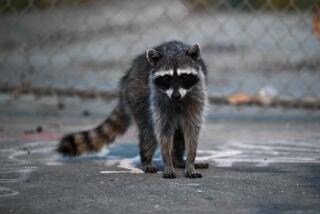Alameda struggles to contain street gangs — of raccoons
- Share via
Reporting from Alameda — Rachel Campos de Ivanov was walking her dog last Sunday night when she saw two eyes glowing in the darkness. Her border terrier barked furiously. The eyes came closer, and she discerned a masked furry critter.
She turned away and her pursuer, a raccoon, charged. Then four other raccoons dropped from the trees and joined the chase.
“I was running as fast as I could and screaming at the top of my lungs, ‘Help! Help! Help!’ ” said the East Bay resident. “I ran about a third of a block, then tripped and fell on the ground.”
Dougie, her 20-pound dog, fended off four of the snarling animals, but the fifth latched onto the woman’s leg and bit her.
Campos de Ivanov, 33, is the ninth raccoon attack victim since June in Alameda, a small, bustling city of tree-lined streets, Victorian-style houses, waterfront cafes, shopping malls and beaches. An island, Alameda is linked to Oakland by short bridges and two underwatertunnels.
Locked in by the bay, the raccoons “don’t have enough territory, so they are acting aggressively toward anything out there that looks like a predator,” said Daniel Wilson, community relations coordinator for the Alameda County Vector Control Services District. Alameda has more than 70,000 people on about 10.8 square miles of land.
“It’s a public safety problem,” Wilson said. “You should be able to walk the streets at night with a dog and not worry about being molested by a raccoon.”
Campos de Ivanov is now receiving a series of painful shots to protect her from rabies, though it is unlikely that her attacker carried the disease. Rabid raccoons are rampant on the East Coast, but the disease is rare among raccoons in the West. Bats and skunks are the prime carriers here, officials said.
“The problem is there is more wildlife in the cities than in the country because there is more food here,” said David Gould, a vector control officer who has worked in Alameda for 20 years. He said all of the attacks involved people with dogs, and the dogs probably incited the raccoons.
“Raccoons are ornery,” Gould said. “They bite the heads off baby chicks.”
He said the U.S. Department of Agriculture has been consulted, and there is talk of trying to trap the animals. But vector control officials say it is not likely to do much good.
Officials may place a trap in the city park where the raccoons that chased Campos de Ivanov were living — “just as a P.R. gesture,” Gould said. “It’s the humans that need to stop leaving out food.”
Raccoon attacks on humans remain unusual, but people can get mauled when they feed the animals or intervene in fights with dogs, officials said. Raccoons also have been known to get dogs into swimming pools and drown them.
“They grab them by the head and hold them under water,” said Gary Beeman, a Northern California wildlife biologist who owns a pest control company, consults with the federal government and has trapped hundreds of raccoons. “Not just little dogs — Labrador size.”
He said a raccoon’s natural predators include mountain lions, coyotes and great horned owls. There are no mountain lions or coyotes in Alameda, vector control officers said.
State law prohibits the relocation of raccoons more than a couple of miles away, but vector control said problem raccoons can be euthanized.
Raccoons usually breed in the spring, and females aggressively protect their offspring. Officials said the group that charged last weekend may have been a mother with her babies and yearlings.
The critters creep into houses in Alameda through pet doors and live in columns on porches. They eat garbage and food that residents leave out for feral cats. One woman saw a gang of raccoons at night and felt too afraid to leave her car, said Campos de Ivanov.
“They are all over the place here, and they are huge,” she said. Males can weigh up to 40 pounds.
In the other Alameda attacks, the dogs fared worse than the humans, although none died, Wilson said. The vector control agency has advised people to take walking sticks when they go out with their dogs at night.
Campos de Ivanov has learned that “running is the wrong thing to do” when being pursued by a raccoon. It incites the animals to chase, she said. She plans to carry pepper spray with her at night in case of further encounters.
Dougie, her 18-month-old terrier, survived the brawl with only a scratch but is being quarantined. He had been vaccinated for rabies before the attack.
Campos de Ivanov said she hopes her experience will discourage people from leaving out food and garbage that have been blamed for the boom in population.
“The animals are getting angry,” she said.
More to Read
Sign up for Essential California
The most important California stories and recommendations in your inbox every morning.
You may occasionally receive promotional content from the Los Angeles Times.











